
Social Media Marketing for Product-Led Growth SaaS Success

by
Wiktoria Slowikowska
Oct 16, 2024
Identify and convert your most valuable users
Sign Up
Product-Led Growth (PLG) has emerged as a powerful strategy for driving user acquisition and retention. At its core, PLG puts the product at the forefront of the customer journey, allowing users to experience value before committing to a purchase. But how can we amplify this approach? The answer lies in the strategic use of social media marketing.
Understanding the PLG and Social Media Connection
Product-Led Growth is more than just a buzzword; it's a fundamental shift in how we think about user acquisition and retention. In a PLG model, your product becomes its own best salesperson. Social media, with its vast reach and engagement potential, serves as the perfect stage for your product to showcase its capabilities to a wide, engaged audience.
Consider this: companies that adopt a PLG strategy experience 50% faster revenue growth and 30% lower customer acquisition costs compared to their peers. These numbers highlight the potential of PLG, and when combined with effective social media marketing, the results can be truly transformative.
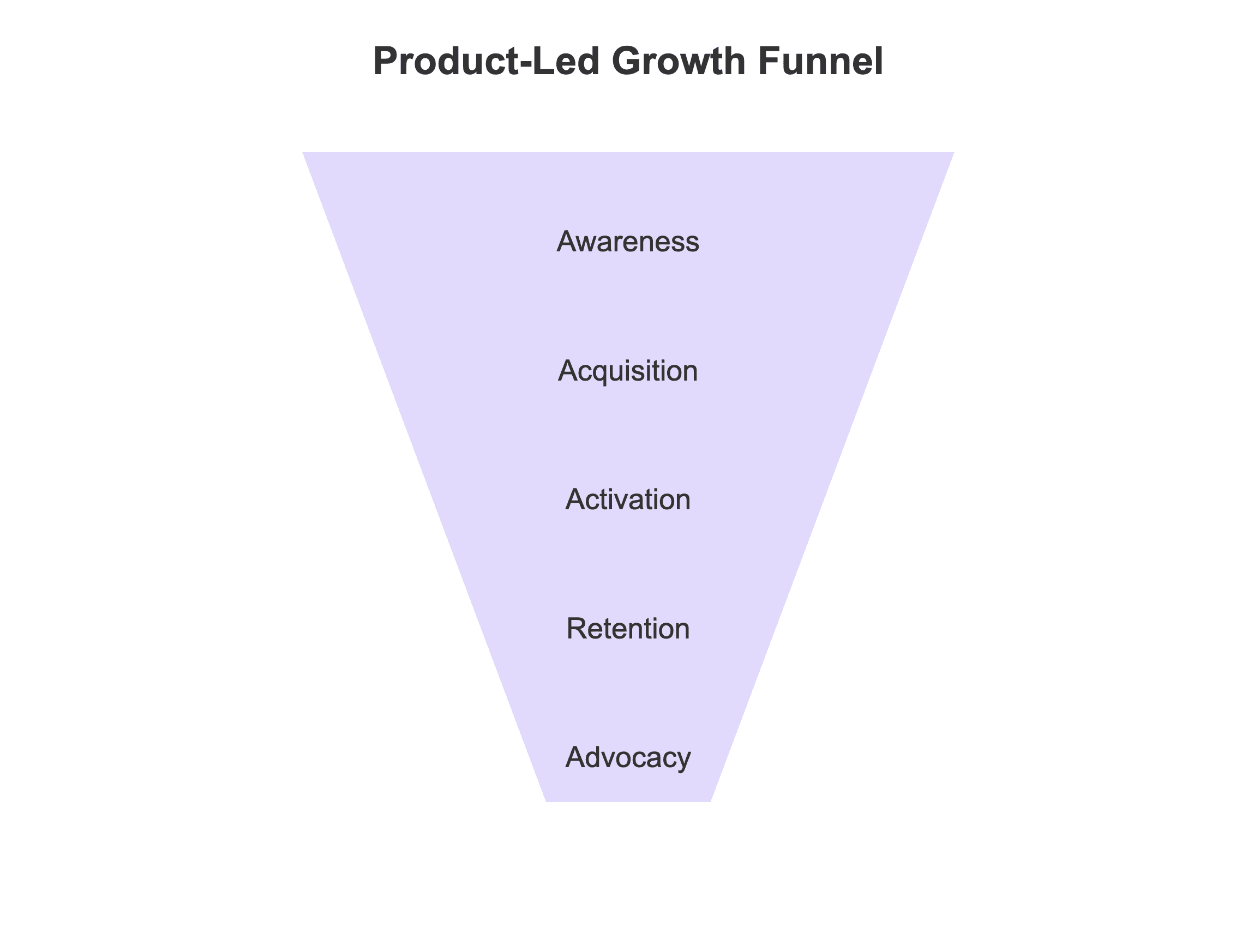
Now, let's dive into the key components of a successful social media strategy for PLG SaaS products.
1. Know Your Audience
Before crafting your social media strategy, it's crucial to understand who you're talking to. Social listening goes beyond basic demographics; it's about uncovering the pain points, aspirations, and behaviors of your potential users.
Here's how to approach social listening effectively:
Identify Key Conversations: Use tools like Sprout Social, Hootsuite, or Mention to monitor discussions about your product category, competitors, and related industry topics.
Analyze Sentiment: Look beyond mere mentions. Understand the emotional context behind user comments. Are they expressing frustration with existing solutions? Excitement about new features?
Track Trending Topics: Stay informed about emerging trends in your industry. This can guide both your product development and content strategy.
Competitor Analysis: Monitor your competitors' social media activities. What types of content resonate with their audience? What complaints do users have about their products?
Tip: Don't just collect data; analyze it. Look for patterns and insights that can inform not just your social media content, but your product development as well.
2. Choosing the Right Platforms
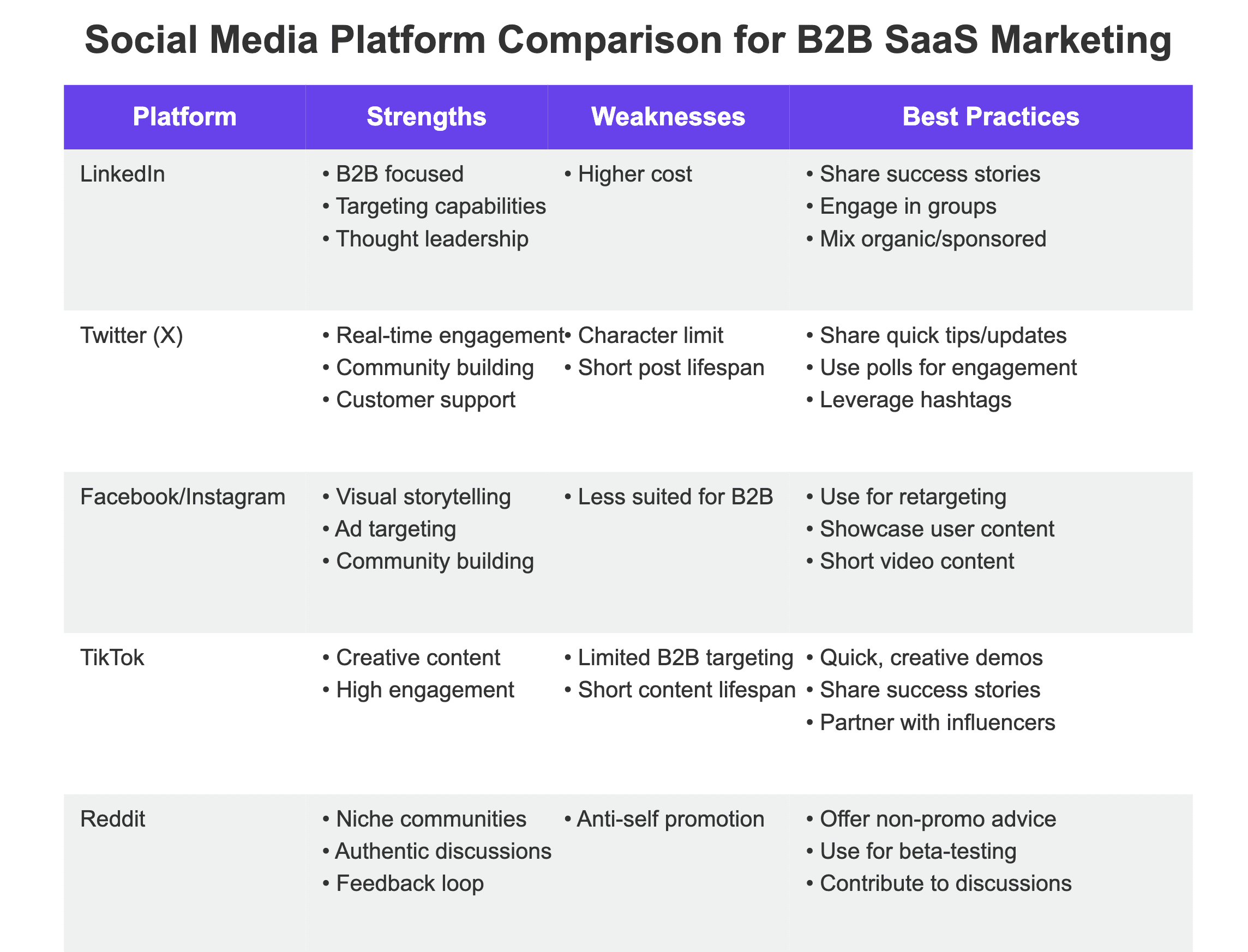
Not all social media platforms are created equal, especially when it comes to B2B SaaS products. Let's break down the most effective platforms for PLG SaaS marketing:
Why It's Effective:
LinkedIn is the gold standard for B2B SaaS, especially for products targeting professionals, decision-makers, or enterprises. The platform is designed to facilitate networking and knowledge-sharing among business professionals.
Strengths:
Targeting Capabilities: LinkedIn’s ad platform allows for highly granular targeting, including job titles, industries, company size, and more. This ensures your content is reaching the right decision-makers.
Thought Leadership: It’s the ideal space for thought leadership, which is crucial in B2B SaaS. Sharing case studies, whitepapers, or insightful articles helps establish your brand as an authority.
B2B Focused Content: Posts with professional insights, industry news, or reports perform well and can lead to higher engagement with a relevant audience.
Weaknesses:
Cost: LinkedIn ads can be more expensive than other platforms. Cost-per-click and cost-per-impression rates tend to be higher, but they often lead to higher-quality leads.
Best Practices:
Share customer success stories that showcase the ROI of your product.
Engage in relevant industry groups where discussions align with your product's value proposition.
Use a mix of organic and sponsored posts, including whitepapers or webinars as lead magnets.
Twitter (now X)
Why It's Effective:
Twitter is all about real-time engagement, perfect for staying relevant in industry trends and sharing quick insights. SaaS companies often use it to engage with their audience directly, respond to queries, and share content in easily digestible bits.
Strengths:
Real-Time Conversations: Twitter’s fast-paced nature allows SaaS brands to participate in trending discussions, respond to customer questions in real-time, and position themselves as thought leaders through continuous engagement.
Community Building: By following industry influencers and participating in conversations, SaaS brands can build relationships and grow their audience organically.
Customer Support: Twitter is frequently used for customer service and quick problem resolution, which can showcase your responsiveness and care.
Weaknesses:
Character Limit: The short format limits the depth of content. Twitter may not be ideal for complex product details or lengthy explanations.
Short Lifespan of Posts: Tweets have a shorter shelf life compared to posts on LinkedIn or Facebook. You need a higher posting frequency to remain visible.
Best Practices:
Share bite-sized product tips, updates, or industry insights multiple times a day.
Use Twitter polls to engage your audience and collect quick feedback on potential new features or customer preferences.
Leverage hashtags and participate in industry conversations to increase visibility.
Facebook and Instagram
Why They're Effective:
Facebook and Instagram excel in B2C SaaS or SaaS products with a strong visual component, as they allow for creative storytelling through images and videos. Instagram is especially powerful for visually engaging content.
Strengths:
Facebook’s Ad Targeting: Facebook allows you to target very specific audiences based on demographics, interests, behaviors, and even life events, making it effective for highly personalized SaaS product promotions.
Visual Storytelling on Instagram: For SaaS products that benefit from showcasing visual workflows, customer-generated content, or design-driven elements, Instagram is a great platform.
Community Building: Facebook Groups can be used to build a tight-knit community where users can share feedback, product ideas, and experiences.
Weaknesses:
Less Suited for B2B: Facebook and Instagram tend to be less effective for traditional B2B SaaS companies unless there’s a strong visual element to the product. Their audience is more consumer-oriented.
Best Practices:
Use Facebook for retargeting campaigns to reach users who have visited your site but haven’t converted.
On Instagram, showcase user-generated content, and use stories to highlight behind-the-scenes content or feature updates.
Leverage short, snappy video content to explain your product’s value proposition in an engaging way.
Example: Canva makes exceptional use of Instagram, showcasing user-generated content, creative design inspiration, and short tutorials that highlight the ease of use of their product.
TikTok
Why It's Effective:
Though relatively new for SaaS, TikTok’s growing user base and short-form video format make it ideal for creatively engaging a younger audience, particularly startups and young entrepreneurs.
Strengths:
Creative Content: TikTok allows for more creativity in how you present your product. Its short, punchy videos can be great for quick product demonstrations, tips, or even light-hearted content that humanizes your brand.
High Engagement: The platform’s algorithm pushes engaging content to a broader audience, giving your product the chance to go viral, even with a relatively small following.
Weaknesses:
Limited Targeting for B2B: TikTok’s audience skews younger and more consumer-focused. It may not be the best platform for SaaS brands targeting enterprise clients.
Content Lifespan: TikTok videos can have a very short shelf life unless they catch on, so brands must continuously post engaging content to maintain visibility.
Best Practices:
Use TikTok to create quick, creative demos of your product in action.
Share success stories or tutorials in short, digestible clips.
Partner with influencers who can organically introduce your SaaS product to a wider audience.
Example: Later, a social media scheduling tool, excels on TikTok by sharing quick social media marketing tips and creative use cases for their product, making their educational content fun and engaging.
Why It's Effective:
Reddit’s unique, community-driven nature makes it a valuable platform for SaaS companies looking to engage in authentic, meaningful conversations with niche audiences. It's particularly good for gathering feedback and insights directly from users.
Strengths:
Niche Communities: Reddit’s subreddit structure means you can find highly targeted communities related to specific industries or products. These are often highly engaged and receptive to thoughtful, non-promotional content.
Authentic Discussions: Redditors appreciate transparency. If your SaaS product addresses a specific pain point for a community, thoughtful participation can help you gain trust and build authority.
Feedback Loop: You can use Reddit to gather feedback directly from potential users or customers. Many tech companies participate in AMAs (Ask Me Anything) sessions to answer questions and gather insights.
Weaknesses:
Anti-Self Promotion Culture: Reddit users are highly sensitive to overt marketing. Any content perceived as too promotional can be downvoted or removed by moderators, so the key is to contribute value first.
Best Practices:
Participate in relevant subreddits by offering helpful, non-promotional advice or answering user questions.
Use Reddit for beta-testing new features, gathering user feedback, or even running AMAs with your founders or product teams.
Build brand awareness by contributing to discussions about broader industry topics.
Example: Notion engages with productivity and tech communities on Reddit, answering user questions, providing updates, and using feedback to enhance their product.
Tip: Don't spread yourself too thin. It's better to excel on one or two platforms than to have a mediocre presence across all of them. Choose the platforms where your target audience is most active and engaged.
3. Content Strategies: Showcasing Value Through Storytelling
Your social media content should do more than just promote your product; it should tell a story of value and transformation. Here are some effective content strategies for PLG SaaS:
Feature Demonstrations: Create short, engaging videos that showcase how your product solves real-world problems. Focus on the user experience and the "aha" moments that demonstrate your product's value.
User Success Stories: Share testimonials and case studies that highlight how your product has made a tangible difference for your customers. These stories serve as powerful social proof.
Educational Content: Position your brand as a thought leader by sharing industry insights, tips, and best practices. This approach builds trust and demonstrates expertise.
Behind-the-Scenes Glimpses: Give your audience a peek into your company culture, product development process, or upcoming features. This transparency can foster a stronger connection with your audience.
Interactive Content: Engage your audience with polls, quizzes, or challenges related to your product or industry. This can boost engagement and provide valuable insights into your audience's preferences.
Tip: Always tie your content back to user benefits. Instead of listing features, show how those features translate into real-world advantages for your users.
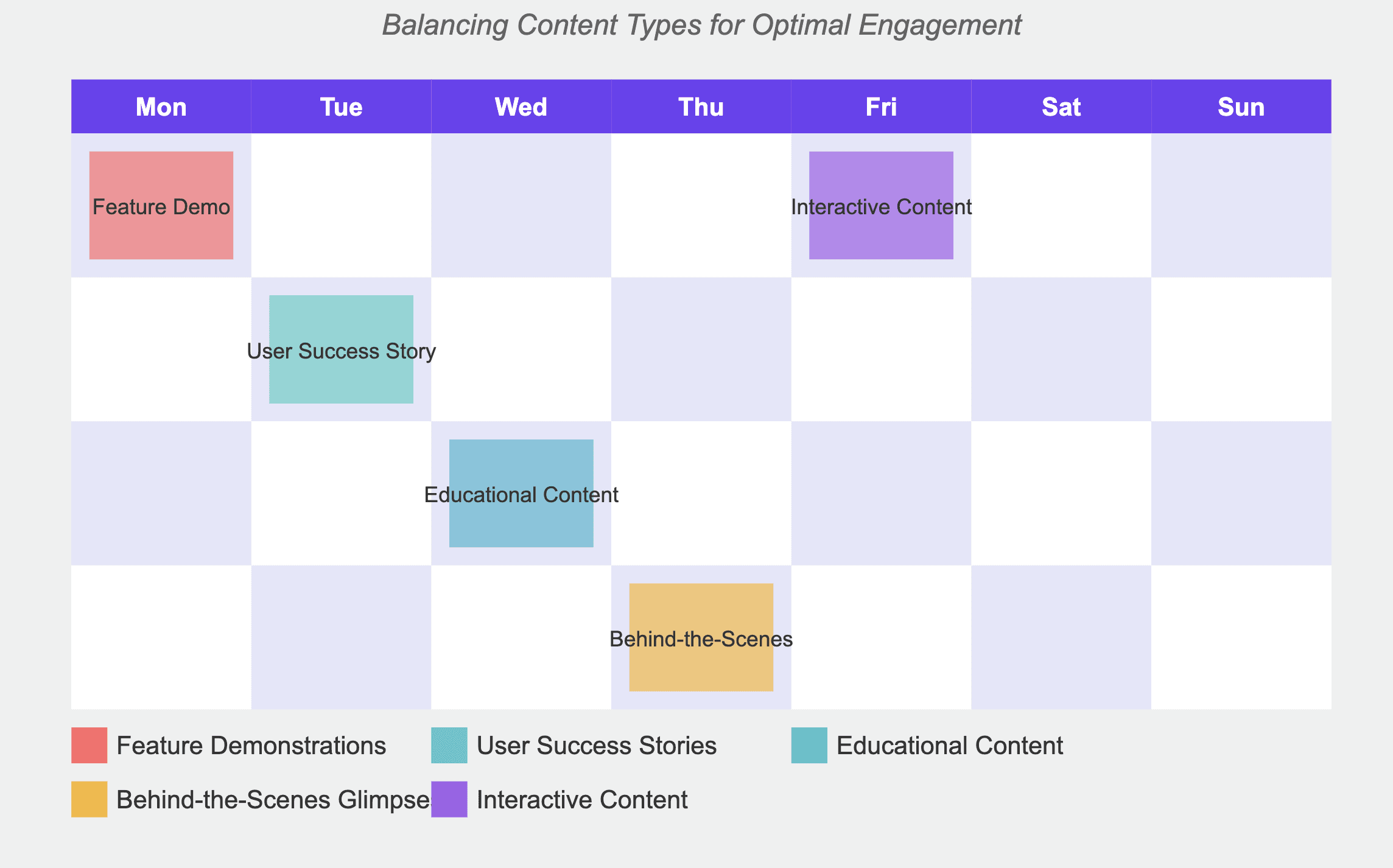
4. Leveraging Social Proof: Let Your Users Do the Talking

In the world of PLG, social proof is a powerful tool. Your satisfied users can be your most effective advocates. Here's how to leverage their experiences:
Encourage Reviews: Make it easy for users to share their experiences on social platforms. Consider creating a branded hashtag for user reviews.
Showcase Milestones: Celebrate user achievements that were facilitated by your product. This not only recognizes your users but also demonstrates the tangible benefits of your SaaS offering.
User-Generated Content: Encourage users to share how they use your product in their day-to-day operations. This authentic content can be incredibly persuasive to potential customers.
Influencer Partnerships: Collaborate with industry influencers or thought leaders to showcase your product. Their endorsement can lend credibility and expand your reach.
Tip: Always seek permission before sharing user content, and consider offering incentives (like feature spotlights or premium account upgrades) for users who contribute high-quality testimonials or use cases.
5. Building a Community
Building a community around your product can significantly boost your PLG efforts. Social media provides the perfect platform for this. Consider these strategies:
Host Regular Q&A Sessions: Use live video features on platforms like Instagram or LinkedIn to answer user questions in real-time.
Create User Groups: Establish spaces (like Facebook Groups or LinkedIn Groups) where users can share tips, ask questions, and connect with each other.
Engage in Conversations: Don't just broadcast; participate. Respond to comments, join relevant discussions, and show that there are real people behind your brand.
Run Contests and Challenges: Encourage user engagement through contests that showcase creative uses of your product or challenges that solve industry-specific problems.
Offer Exclusive Content: Provide your social media followers with exclusive content, early access to new features, or special discounts to reward their loyalty.
Tip: Empower your power users by giving them special roles within your community. This not only recognizes their expertise but also provides valuable peer-to-peer support for your user base.
6. Measuring Success
To ensure your social media efforts are paying off, it's crucial to track and analyze the right metrics. Focus on:
Engagement Rates: Look beyond likes and followers. Measure comments, shares, and meaningful interactions that indicate genuine interest in your product.
Click-Through Rates: Monitor how effectively your social media content is driving traffic to your product pages or sign-up forms.
Conversion Rates: Track how many social media visitors actually sign up for trials or become paying customers.
Customer Acquisition Cost (CAC): Calculate how much you're spending on social media marketing to acquire each new customer.
Customer Lifetime Value (CLV): Measure the total value a customer brings to your business over their entire relationship with your product.
Interestingly, companies that excel at using customer data outperform their peers by 85% in sales growth. This underscores the importance of not just collecting data, but using it to inform your strategy.
Tip: Regularly review your metrics and be prepared to pivot your approach based on what the data tells you. Social media algorithms and user behaviors change frequently, so staying agile is key.
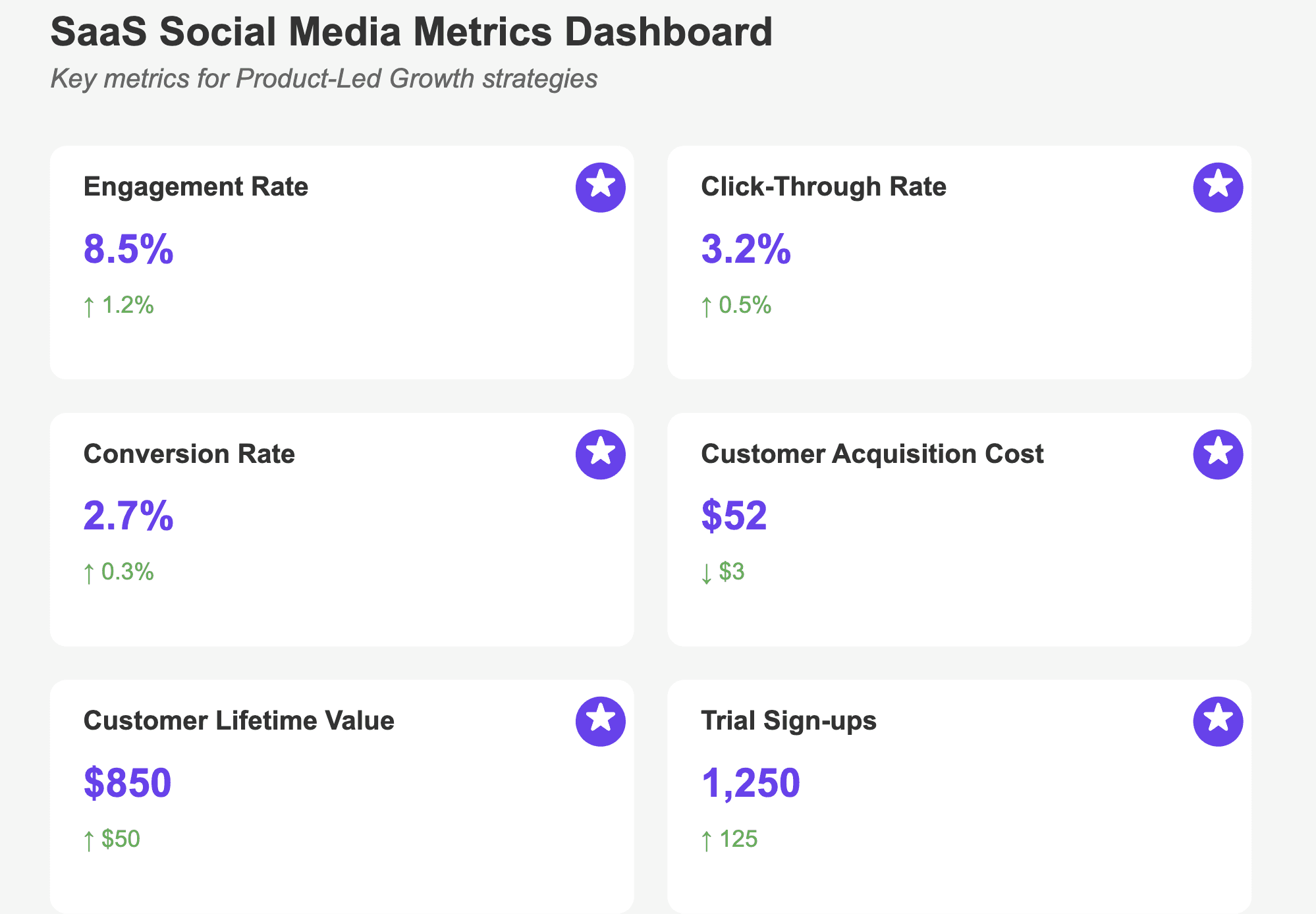
Conclusion
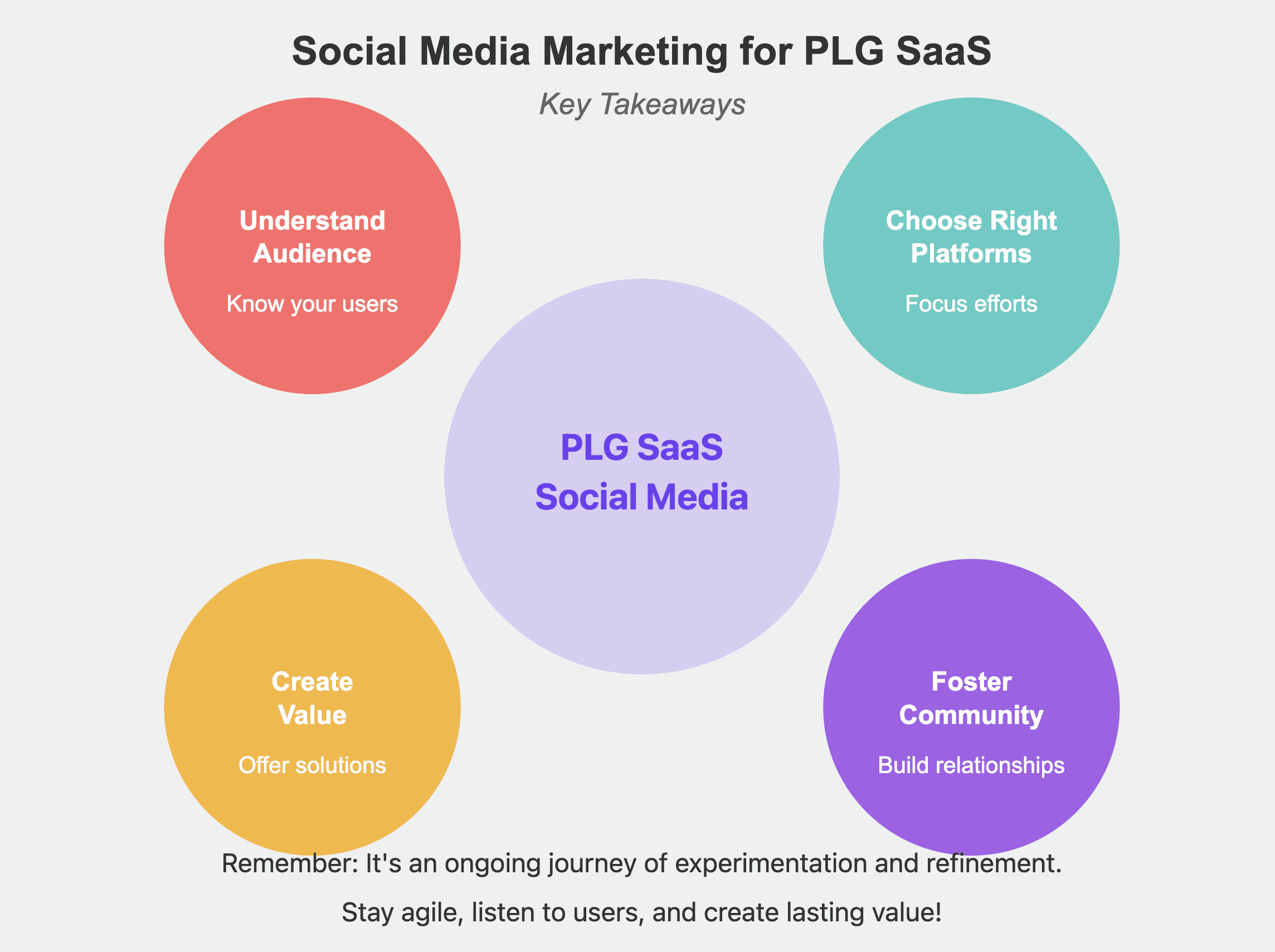
As we've explored, social media marketing plays a crucial role in amplifying the success of Product-Led Growth strategies for SaaS companies. By understanding your audience, choosing the right platforms, creating valuable content, fostering community, and leveraging both organic and paid strategies, you can create a powerful synergy between your product and your social media presence.
Remember, social media marketing for PLG SaaS is not a one-time effort, but an ongoing journey of experimentation, learning, and refinement. Stay agile, keep listening to your users, and don't be afraid to try new approaches. Your product has a story to tell – let social media be the compelling narrator that draws users in and keeps them engaged.
By harnessing the power of social media in alignment with your PLG strategy, you're not just marketing a product; you're building a community, solving real problems, and creating lasting value for your users. And in the dynamic world of SaaS, that's the key to sustainable growth and enduring success.




